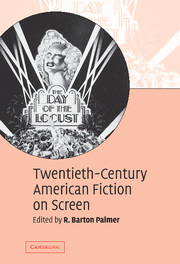Book contents
- Frontmatter
- Contents
- List of illustrations
- Notes on contributors
- Acknowledgments
- Introduction
- 1 Filming an unfinished novel: The Last Tycoon
- 2 The texts behind The Killers
- 3 The Day of the Locust: 1939 and 1975
- 4 Ship of Fools: from novel to film
- 5 Intruder in the Dust and the southern community
- 6 Dramatizing The Member of the Wedding
- 7 Film and narration: two versions of Lolita
- 8 World War II through the lens of Vietnam: adapting Slaughterhouse-Five to film
- 9 John Huston's Wise Blood
- 10 Genre and authorship in David Cronenberg's Naked Lunch
- 11 Screening Raymond Carver: Robert Altman's Short Cuts
- 12 The Color Purple: translating the African-American novel for Hollywood
- 13 The specter of history: filming memory in Beloved
- 14 Filming the spiritual landscape of James Jones's The Thin Red Line
- Filmography
- Index
- References
9 - John Huston's Wise Blood
Published online by Cambridge University Press: 12 January 2010
- Frontmatter
- Contents
- List of illustrations
- Notes on contributors
- Acknowledgments
- Introduction
- 1 Filming an unfinished novel: The Last Tycoon
- 2 The texts behind The Killers
- 3 The Day of the Locust: 1939 and 1975
- 4 Ship of Fools: from novel to film
- 5 Intruder in the Dust and the southern community
- 6 Dramatizing The Member of the Wedding
- 7 Film and narration: two versions of Lolita
- 8 World War II through the lens of Vietnam: adapting Slaughterhouse-Five to film
- 9 John Huston's Wise Blood
- 10 Genre and authorship in David Cronenberg's Naked Lunch
- 11 Screening Raymond Carver: Robert Altman's Short Cuts
- 12 The Color Purple: translating the African-American novel for Hollywood
- 13 The specter of history: filming memory in Beloved
- 14 Filming the spiritual landscape of James Jones's The Thin Red Line
- Filmography
- Index
- References
Summary
Peter S. Greenberg: “The movie Wise Blood didn't exactly make you rich either, did it?”
John Huston: “No, but it was one of the finest movies I think I've ever made.”
–Peter S. Greenberg, “‘Saints and Stinkers’: The Rolling Stone Interview” (1981)John Huston may have regarded Wise Blood highly, but film studies has had comparatively little interest in it, favoring other, “classic” Huston films. In some ways, this is understandable. Wise Blood is an acquired taste: a low-budget, independently financed film with no stars that closely follows the Georgia author Flannery O'Connor's (1925–1964) bizarre, comic-horrific account of the southern orphan Hazel Motes's futile rebellion against his religious heritage. The characters are wholly unsympathetic, their interactions unpredictable and highly episodic, and the film, like O'Connor's novel, adopts a cool, ironic, and blackly humorous tone toward their truly outlandish antics.
Yet the more closely one examines the film, the more one is struck by how artfully it conveys O'Connor's highly symbolic, theologically imbued story. While adaptation studies has taken stock of and dismissed the notion of a film's “fidelity” to a source-text, Wise Blood is one adaptation where fidelity was the keynote principle of the filmmakers and the film itself. Equally compelling is how well its concerns coincide with those of many of Huston's other films – even though Huston himself did not write the film's screenplay. For the film features an uncanny conjunction of O'Connor's distinctive view of southern male identity gone awry with Huston's much-appreciated debunking of American masculine ethos.
- Type
- Chapter
- Information
- Twentieth-Century American Fiction on Screen , pp. 144 - 169Publisher: Cambridge University PressPrint publication year: 2007



